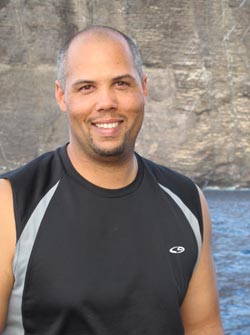
2011 Papahānaumokuākea Intertidal Monitoring Cruise Survey Team Reflections: Levi Lewis – Scripps Institution of Oceanography
I grew up in San Diego, California playing in, on and near the ocean. I am now a third-year PhD student at Scripps Institution of Oceanography, in San Diego. My advisor is Dr. Jennifer Smith, a graduate of the University of Hawaii, Mānoa and a friend / colleague of Dr. Chris Bird, one of the Principal Investigators on this trip. Our lab specializes on limu-coral interactions and the importance of animal-plant interactions in tropical reef ecosystems. Dr. Bird invited me to join the expedition to assist with limu samples and data collection.
This trip has been amazing. I've learned a ton about the ecology, archaeology, geology and anthropology of the Northwestern Hawaiian Islands (NWHI). This trip provided the unique opportunity to directly work with and discuss both the ecological and cultural significance of the monument with resource managers, scientists, and native Hawaiian cultural leaders. On this trip, I personally hoped to learn about the cultural and ecological significance of the NWHI. Scientifically, I aimed to develop a specimen and digital archive of the intertidal algae of each of the four rock pinnacles that we were to visit. The magnificent visibility, beautiful colors, and warmth of the NWHI waters contrast strongly with the cool, nutrient rich coastal waters of San Diego. The diversity was not substantially greater, but that is to be expected for remote islands such as those in the NWHI chain. Surprisingly, many species within the NWHI have very similar cousins found in San Diego's waters.
For the future, I think all scientists and researchers need an understanding of the place, people, and culture within which their research is imbedded. Combining cultural experts along with scientists is a beautiful plan that elevates the value of the research conducted far beyond simple data collection and will likely contribute immensely to the success of future conservation efforts. It's clearly important that we need to monitor Papahānaumokuākea Marine National Monument as a model of restoration and a baseline for how healthy ecosystems should appear and function.
One of my favorite moments was swimming with a giant curious white-tip reef shark. He showed now fear, swimming up from 30 ft. below to check us out, providing some great photo opportunities, and gliding gently into the vortex of bubbles created by the waves above. At first, I was overwhelmed: the size of the ocean, the sheer rock faces, the pounding waves, the slippery surfaces. However, I quickly grew comfortable and grew fond of the entire situation. I felt a simultaneous warmth and cautious respect for each island. Furthermore, the spiritual chants of Kehau, Pat, Brian and Hoku made each location feel spiritually special, beyond the magnificent wildlife and scenery.
I'm taking away a newfound understanding of the value of the NWHI monument, the value of people and place, the value of culture and history. I'm also taking away hundreds of limu samples and pictures that I look forward to picking through and playing taxonomist. If I return, I'd like the opportunity to explore more of the fringing reefs around the pinnacles and spending more time in the subtidal. The plating acroporids at Mokupāpapa (French Frigate Shoals) were particularly beautiful and fascinating and I expect the fringing reefs are beautifully loaded with them and the complex, ornate communities of organisms they support.
Click Here for more Survey Team Reflections.
